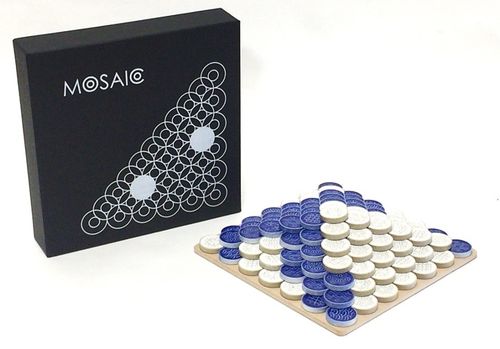|
Advertisement
|
Mosaic

DescriptionMosaic is a two-player board game like Go and Othello. However, what differs from Go and Othello is that it is a 3D game that extends the position not only in the plane but also in the vertical direction. You can solidify your footsteps first, expand the territory, or hold down the upper floors early to divide the opponent's piece or develop a complex bargain. And from the middle to the end of the game, the pieces of each other pile up at once, and a dynamic reversal play occurs. Once you play it, you should be able to understand the benefits. The game board has 7 x 7 = 49 holes, and a neutral piece is fixed at the center from the beginning. Two players each have 70 pieces. The game is as follows.
The fun of the game called mosaic is in the rule that "pieces are stacked in a chain reaction by putting one piece". From the middle of the game, development accelerates at a stretch, and the situation changes rapidly. In the early stage, even if you allow the opponent to lead, I think that the feeling when the development of one-shot reversal at the last moment is reached is unique to mosaics. Gameplay in Mosaic is identical to Margalith Akavya's Upper Hand, but with the action taking place on a larger initial playing area. --user summary Laplace is a two-player abstract strategy game in which your goal is to play all of your pieces before the opponent can. The game is played on a 7x7 grid, and the players each have pieces of a different color. A piece of a third color is placed in the central square on the game board. On a turn, a player places one of their pieces into an empty space on the grid. If a player creates a square of four pieces and at least three of those pieces belong to that same player, then the player immediately places another piece on top of those four pieces; if the placement of that piece also creates a square meeting the same condition, then they place a piece on top of that square. Thus, as more pieces are placed, they collectively form a pyramid, with the bottom layer being 7x7, then the next layer 6x6, and so on. Whoever places their final piece first wins! Gameplay in Laplace is identical to Margalith Akavya's Upper Hand., but with the action taking place on a larger initial playing area. Game DiscussionsAdd CommentYou need to be logged in to comment. Insert Bullet List Please enter at least one item. Item: Item: Item: Item: Item: Insert Numeric List Please enter at least one item. Item: Item: Item: Item: Item: Insert Link Please enter the link of the website Optionally you can add display text Insert Email Please enter the email address Optionally add any display text Insert Image Please enter the link of the image Insert YouTube Video Please enter the link of the video Marketplace | ||||

Comments (0)